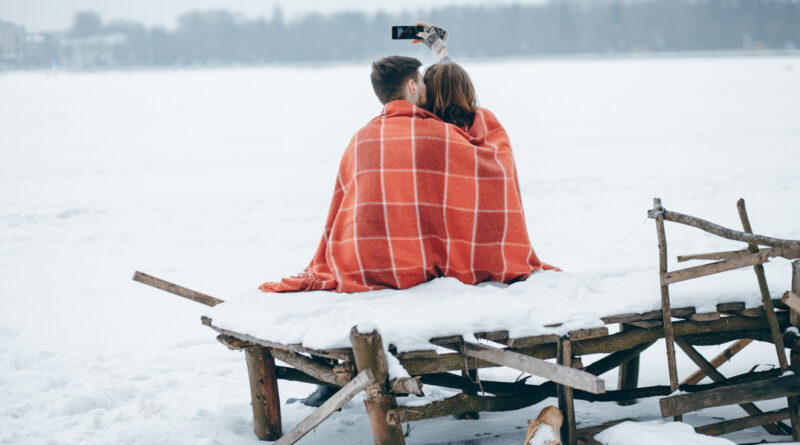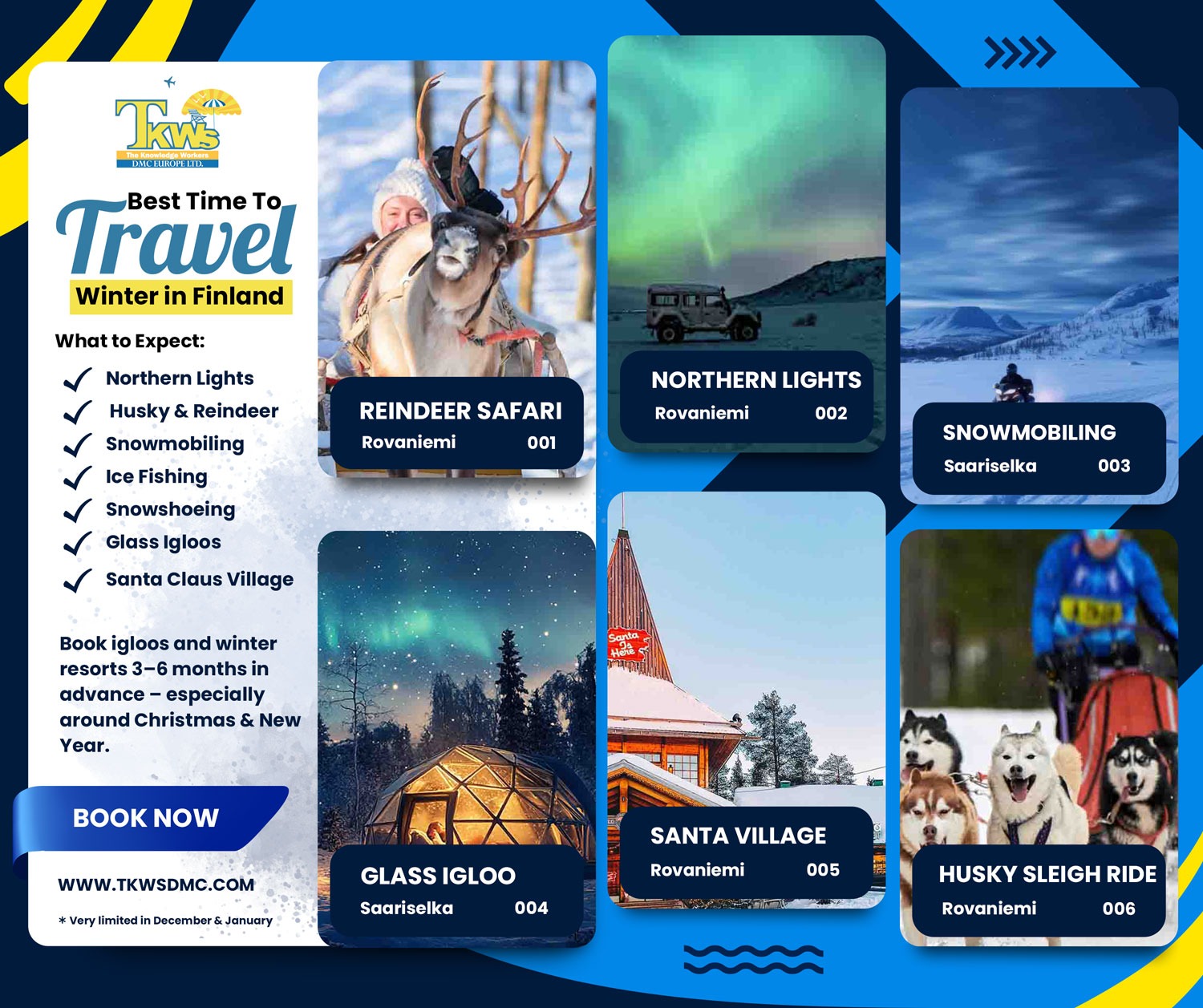Lapland Magic
Lapland Magic (Winter): A Journey into Finland’s Arctic Wonders
When most people imagine Finland, the first picture that comes to mind is a snowy landscape under the shimmering Northern Lights. This enchanting scene is not just a postcard fantasy — it is Lapland in winter, a place where nature, culture, and pure magic come together. In this blog, we will explore the spirit of Lapland’s winter charm — from chasing the auroras to meeting reindeer, from ice-floating adventures to discovering the culture of the Arctic Circle. This isn’t a day-by-day itinerary but a complete picture of what makes Finland’s winter Lapland experience so unforgettable.
The Allure of Lapland in Winter
Lapland is Finland’s northernmost region, stretching into the Arctic Circle, where winters are long, snowy, and full of wonder. The land is covered in white from November until April, transforming forests, lakes, and villages into fairytale-like landscapes. Unlike crowded ski resorts in central Europe, Lapland offers something rare — silence, space, and an unspoiled connection with nature.
The magic of Lapland is not only in the views but in the way life adapts to the Arctic environment. Days are short, nights are long, but that only enhances the mystical atmosphere. Whether it’s stargazing in complete darkness or enjoying daylight filtered through pink and orange Arctic skies, Lapland reminds us that winter is not a season to endure but a wonder to celebrate.
Click to view
Helsinki: The Gateway to Finland
Although Lapland lies in the far north, most journeys begin in Helsinki, Finland’s vibrant capital. Winter in Helsinki offers a fascinating contrast before heading north. The frozen Baltic Sea, cozy cafés with steaming mugs of hot chocolate, and the neoclassical architecture of Senate Square create a Nordic charm.
Helsinki in winter feels alive with cultural experiences — from museums like the National Museum of Finland to contemporary art at Kiasma. Food lovers can warm up with salmon soup or traditional Karelian pies. And if you’re lucky, the city often hosts winter festivals with lights, music, and skating rinks that sparkle against the snow.
Tallinn: A Medieval Winter Wonderland
Many Lapland travelers also stop by Tallinn, the Estonian capital, easily accessible from Helsinki by ferry. This city is like stepping into a medieval storybook, especially in winter when cobblestone streets are dusted with snow. Tallinn’s Old Town is a UNESCO World Heritage site, filled with spires, merchant houses, and cozy cafes.
Exploring Tallinn gives the journey a historical and cultural depth. While Lapland showcases Arctic wilderness, Tallinn provides a glimpse of European medieval heritage. Together, they balance the trip with both nature and history.
Chasing the Northern Lights: A Natural Light Show
The highlight of any Lapland winter adventure is undoubtedly the Northern Lights (Aurora Borealis). Imagine standing in the snow, wrapped in warm clothes, when the sky above suddenly dances with streaks of green, purple, and pink. It’s a sight so surreal that words often fail to capture it.
The science behind the aurora is fascinating — solar particles colliding with Earth’s atmosphere — but the feeling of seeing them is purely magical. Local guides often take visitors to the best viewing spots away from light pollution, sometimes by snowmobile, husky sled, or even reindeer sleigh. Each chase is different, as the aurora never looks the same twice.
BBQ Nights in the Arctic
Winter in Lapland is not just about the cold — it’s about warmth shared in the most unlikely places. One such tradition is the Arctic BBQ night. Picture a wooden hut with a fire crackling inside, surrounded by snow-covered forests. Families and travelers gather to grill sausages, sip hot berry juice, and share stories.
These nights are often combined with aurora hunting. Between watching the skies and enjoying grilled food, the experience blends adventure and comfort. It shows the Finnish way of embracing nature, not fighting it.
Santa’s Village and the Arctic Circle
Lapland is also famous as the home of Santa Claus, and in Rovaniemi, visitors can meet him year-round. Santa’s Village is a magical place where children and adults alike can post letters from the official Arctic Circle Post Office, cross the Arctic Circle line, and meet Santa’s reindeer.
But beyond the festive theme, crossing into the Arctic Circle itself is special. It’s not just a geographical line but a symbolic entry into one of the world’s most unique regions. Few places let you experience Arctic life as seamlessly as Lapland does.
Arctic Wildlife Encounter
Lapland’s wildlife is another treasure. At the Ranua Wildlife Park, visitors can see animals adapted to the harsh climate — polar bears, arctic foxes, owls, and reindeer. Unlike traditional zoos, Ranua focuses on Arctic and northern species, providing an educational yet exciting experience.
Wildlife in Lapland also exists beyond enclosures. Reindeer roam freely, herded by the Sami people, Finland’s indigenous community. Encounters with reindeer are not staged photo opportunities but genuine parts of Lapland’s culture and livelihood.
Ice Floating: An Adventure in Stillness
One of Lapland’s most unique activities is ice floating. Wearing a special survival suit, you can float in frozen lakes surrounded by snow and stars. At first, it might sound extreme, but it’s surprisingly peaceful — like meditating in nature’s cold embrace.
Ice floating is both thrilling and calming, offering a perspective you can’t find elsewhere. It symbolizes the Finnish relationship with nature: trust, respect, and balance.
The Culture of Warmth in the Cold
Lapland’s winter might seem intimidating, but Finnish culture has mastered the art of warmth. The famous sauna tradition is central here. After a day in the snow, locals relax in saunas — sometimes followed by a dip in icy water or a roll in the snow for contrast.
This balance of hot and cold reflects the Finnish philosophy of sisu — resilience, courage, and determination. Experiencing Lapland is not only about activities but about understanding how people thrive in extreme environments with joy and harmony.
Sustainable Travel in Lapland
Travelers are increasingly aware of sustainability, and Lapland sets an excellent example. Many tours are eco-friendly, relying on renewable energy and respecting local traditions. The Sámi culture is preserved and celebrated, showing how tourism can coexist with heritage.
Choosing responsible travel operators ensures that the fragile Arctic environment remains unspoiled for future generations. Whether it’s minimizing plastic use, supporting local crafts, or respecting wildlife, each choice contributes to sustainable exploration.
Why Lapland in Winter Feels Magical
So, what makes Lapland winter truly magical? It’s not just the snow or the auroras. It’s the blend of natural wonders, cultural depth, and emotional connection.
- The Northern Lights remind us of nature’s mysteries.
- Santa’s Village rekindles childhood dreams.
- Wildlife encounters connect us with the Arctic’s resilience.
- Saunas and BBQ nights create human warmth against the cold.
- Ice floating teaches stillness and surrender.
Together, they weave an experience that goes beyond sightseeing. It becomes a story you carry long after the snow melts.
Lapland in winter is more than a travel destination — it’s a state of wonder. From Helsinki’s urban charm to Tallinn’s medieval beauty, from aurora-lit skies to cozy fireside evenings, it offers a journey where every moment feels magical.
The region invites you not just to see but to feel — the silence of snow, the thrill of adventure, the warmth of community, and the wisdom of living with nature. If travel is about transformation, then Lapland’s winter magic is a journey that truly changes you.


